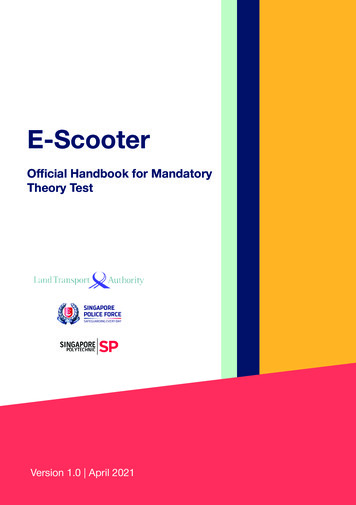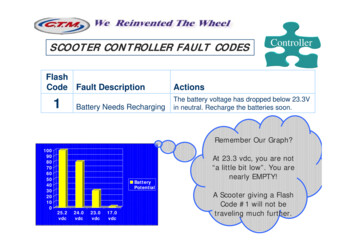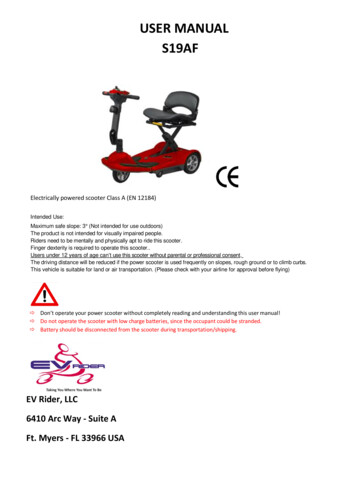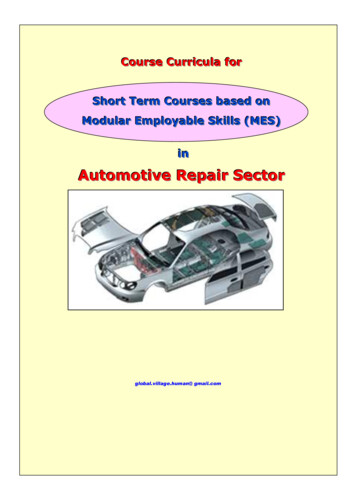
Transcription
E-ScooterOfficial Handbook for MandatoryTheory TestVersion 1.0 April 20211
DisclaimerNo part of this publication may be reproduced or transmitted inany forms or by any means, in parts or whole, without the priorwritten permission of the publisher:Land Transport Authority1 Hampshire RoadSingapore 219428Hotline: 1800 2255 582Published online by Land Transport AuthorityLast updated 28 Apr 2021. The information in this handbook isaccurate at the time of publication.2
ContentsINTRODUCTION5MODULE 1: General Information on Active MobilityDevices in 1.61.7IntroductionTypes of Active Mobility DevicesPersonal Mobility Devices (PMDs)Types of Personal Mobility Devices (PMDs)E-ScootersBicyclesNon-Motorised BicyclesPower-Assisted Bicycles (PABs)Personal Mobility Aids (PMAs)Types of PathsPre-Ride PreparationGuidelines for Riding on Public PathsMODULE 2: Pre-Journey and Equipment Check forE-Scooter Riders2.12.22.32.42.52.62.72.8Device Criteria for E-ScootersUL2272 Certification and Fire SafetyMaintenance of an E-ScooterPre-Ride Equipment Check on E-ScootersSafety Gear and AttireParking, Security and Storage of DevicePlanning Your JourneyThird-Party Liability Insurance388991011111213151617182022242427282930
MODULE 3: Rules and Code of Conduct for Using cooter Handling SkillsStanding on an E-Scooter Without SeatsStarting and StoppingTurning Left or RightMoving in a Straight LineRiding at Low SpeedsRiding Uphill and DownhillTypes of Paths, Signs and PathInfrastructureRecognising Footpaths and Cycling PathsSpecial ZonesPath Signs and MarkingsTypes of Road CrossingsRules and Regulations for PMDs/EScootersCan You Ride a PMD/E-Scooter?Where Can You Ride an E-Scooter?Other Regulations on RidingNavigating Riding ScenariosGood Practices and Code of Conduct –Riding an E-Scooter on Cycling PathsIdentification of Potential HazardsWhat to Do in an AccidentAPPENDIX A313434353535353636363840444848484951545557594
IntroductionThis handbook aims to provide the necessary information forusers of electric scooters (e-scooters) to ride these devices onpaths in a safe and responsible manner. Knowing and applyingthe safety guidelines will help to reduce accidents and cultivatea gracious active mobility culture. In addition, users who do notcomply with the rules may face prosecutorial action.The handbook will cover the following modules:Module 1General Information on Active Mobility Devicesin SingaporeModule 2Pre-Journey and Equipment Check forE-Scooter RidersModule 3Rules and Code of Conduct for Using anE-Scooter5
Module 1MODULE 1General Information on ActiveMobility Devices in Singapore6
Module 1Learning OutcomesIdentify four active mobility devices.List the types of paths where each device can be ridden.List at least five guidelines for riding on public paths.1.2.3.Topics1.1Introduction1.2Personal Mobility Devices (PMDs)1.3Bicycles1.4Personal Mobility Aids (PMAs)1.5Types of Paths1.6Pre-Ride Preparation1.7Guidelines for Riding on Public Paths7
Module 11.1 IntroductionThis module introduces the different types of active mobilitydevices and provides an overview of the rules pertaining tousage and ownership of active mobility devices, active mobilitycode of conduct and safe riding tips.1.1.1 Types of Active Mobility DevicesActive mobility devices can be broadly categorised intothe following types:a)Personal Mobility Devices (PMDs)Motorised PMDs:Electric scooters(e-scooters),hoverboards etc.Non-motorisedPMDs: Kick-scooters,skateboards etc.b)BicyclesPedal bicyclesPower-assistedbicycles (PAB)c)Personal Mobility Aids (PMAs)8
Module 11.2 Personal Mobility Devices (PMDs)This group of devices covers a variety of wheeled vehicles builtto transport people. They may be propelled by an electric motor,human power or both. This does not include PMAs, bicycles,inline skates or roller-skates.All PMDs can be ridden on cycling paths but only non-motorisedPMDs can be ridden on footpaths. All PMDs cannot be riddenon roads.1.2.1 Types of Personal Mobility Devices(PMDs)Examples of motorised PMDs include hoverboards, unicyclesand motorised thersExamples of non-motorised PMDs include skateboards andkick-scooters.SkateboardKick Scooter9
Module 11.2.2 E-ScootersE-scooters are motorised PMDs with handlebars. Ownersshould take note of the following information:a)E-scooters must be registered withLTA.b)E-scooters must be inspectedfor device compliance by LTAauthorised E-Scooter InspectionCentres.c)E-scooters must be affixed with a registration mark andidentification mark. The registration mark is a stickerissued by the inspection centre bearing LTA’s logo andthe registration number.d)You need an E-Scooter Theory Test Certificate to ride ane-scooter*.e)E-scooters can only be ridden on cycling paths.f)All motorised PMDs, including e-scooters, must becertified to the UL2272 fire safety standard. You shouldadopt proper and safe handling habits, to minimise therisk of fire incidents.g)The minimum age to ride an e-scooter is 16 years old.Under-aged riders can ride under supervision by an adult(at least 21 years old) who has obtained an E-ScooterTheory Test Certificate*.*Only applicable when theory test requirement is implemented.10
Module 11.3 BicyclesA bicycle, also called a bike or cycle, is a human-poweredor motor-powered, pedal-driven vehicle, having two wheelsattached to a frame, one behind the other.1.3.1 Non-Motorised BicyclesTypes of non-motorised bicycles:a)b)c)d)e)Road BicyclesMountain BicyclesTrack Bicycles / Fixed Gear BicyclesHybrid BicyclesFoldable Bicycles11
Module 11.3.2 Power-Assisted Bicycles (PABs)A Power-Assisted Bicycle(PAB), also commonlyknown as an e-bike, lookslike a conventional bicycle,except that it is equippedwith an electric motor toassist with pedalling.Important Information on PABsa)PABs need to be type-approved, sealedand registered at an LTA-authorisedInspection Centre before use.b)PABs should have a clearly visiblenumber plate affixed on the rear of thedevice.c)You need a PAB Theory Test Certificateto ride a PAB*.d)PABs can be ridden on cycling pathsand on roads.e)The minimum age for riding a PAB is 16years old; the same age limit is appliedfor pillion passengers on PABs.*Only applicable when theory test requirement is implemented.12
Module 11.4 Personal Mobility Aids (PMAs)Personal Mobility Aids (PMAs) include wheelchairs, motorisedwheelchairs or mobility scooters which are designed to carry anindividual who is unable to walk or has walking difficulties. PMAscan be ridden on cycling paths and footpaths.13
Module 1TYPES OF ACTIVE MOBILITY DEVICESPMD PMD motorised rd, skateboard,motorised kick-scooter)skateboard)Where to ride?RULESPMD e-scooterRegisterwith LTA?YesNoNoCycling Theory sNoNoYesYesNoMax unladen wt. - 20kgMax unladenwt. - 20kg(on paths)Max width 70 cmMax width 70 cm(on paths)Certified to UL2272fire safety standardEN15194compliantMax speed 25km/hMaxMotordeviceassistmust cut speed of10km/h foroff at25km/h motorisedPMAs16 yrs old. 16 yrs,must besupervisedby anadult whopassed theE-scooterTheoryTest*Yes*Rider: 16yrs old16 yrs oldNoNoNoNoNoPillion: 16yrs oldYes**Only applicable when theory test requirement is implemented.14NoNo
Module 1The chart below summarises the types of paths and roads, andthe types of devices allowed on them.1.5 Types of Pathsa)Cycling Paths have markings on theground. These paths have a speedlimit of 25km/h and can be used by allactive mobility devices.b)Footpaths do not have any ‘Cyclist’or ‘PCN’ path markings. The speedlimit for footpaths is 10km/h. Nonmotorised devices and PMAs can beused on footpaths.15
Module 11.6 Pre-Ride Preparationa)Wear bright-coloured clothing to increase your visibility toother vehicles and pedestrians.b)Check that your lights, brakes and tyres are in goodworking condition before setting off.c)Check that you are comfortable and in full control of yourdevice. Adjust your seat or handlebars before setting off.d)Check that all loads and accessories are properly securedand do not affect your ability to control the device.e)Plan your ride ahead of time and pick the safest route.On paths, choose a route with cycling paths as much aspossible. For bicycles and PABs on roads, avoid heavytraffic for your own safety.HELMETBRIGHT COLOUREDCLOTHINGCOVERED SHOESNO LOOSE LOADS16
Module 11.7 Guidelines for Riding on Public PathsBe gracious to other users to keep everyone safe. When ridingon paths, always give way to more vulnerable users such aspedestrians. Riders are encouraged to adopt the followingguidelines when riding on public paths:a)Always give way to pedestrians.b)Watch your speed and go slow around others.c)Slow down when approaching bus stops and/orintersections of public paths.d)Dismount and walk your device in crowded areas.e)Gently alert others before overtaking.f)Keep left on paths unless overtaking.g)Keep a safe distance from other path users, especiallywhen overtaking, to avoid a collision.h)Avoid shining your lights onto the face of other pathusers.i)Keep both hands on the handlebars. Signal your intentionto change course or make a turn ahead of time.j)Ride on cycling paths and bicycle crossings whenavailable.k)Park your device at designated parking places such asbicycle racks and yellow boxes.17
Module 2MODULE 2Pre-Journey and Equipment Checkfor E-Scooter Riders18
Module 2Learning Outcomes1.2.3.4.5.6.List the e-scooter device criteria.Explain the safety reasons for the device criteria.Explain the importance of UL2272 certification.List at least 4 guidelines in preventing device fires.Describe at least 3 pre-ride checks on an e-scooter.Be able to plan your journey on an e-scooter.Topics2.1Device Criteria for E-Scooters2.2UL2272 Certification and Fire Safety2.3Maintenance of an E-Scooter2.4Pre-Ride Equipment Check on E-Scooters2.5Safety Gear and Attire2.6Parking, Security and Storage of Device2.7Planning Your Journey2.8Third-Party Liability Insurance19
Module 22.1 Device Criteria for E-ScootersE-Scooter Device Criteria and Illegal ModificationAll PMDs, including e-scooters, must comply with the followingdevice criteria while travelling on public paths. Do not modifyyour device.a)Maximum unladen weight of 20kg to reduce the risk ofserious injuries in the event of collision. Unladen weightrefers to the device’s weight before any additional loads,but includes attached accessories (e.g. a water bottleholder counts towards the unladen weight, but a waterbottle does not).b)Maximum width of 70cm to allow devices to cross eachother safely on public paths.c)Maximum speed of 25km/h (for motorised devices) toensure that users do not exceed the speed limit forcycling paths.d)UL2272 certified (for motorised devices) for fire safety.Do not modify or tamper with the device’s originalelectrical components as it will void the UL2272certification and poses a fire risk.Do not connect external battery packs to youre-scooter unless your device was certified to beused with an additional battery.20
Module 2Registered e-scooters must be inspected every 2 years toensure compliance with device criteria. Failure to do so willresult in a fine and your e-scooter being deregistered.E-Scooter RegistrationYour e-scooter must be registered before it can be used onpublic paths. It is an offence to ride an un-registered e-scooteron public paths.a)All new e-scooters must pass the registration inspectionbefore they can be registered with LTA.b)Upon registration, the device will beissued a unique registration numberand a LTA-issued registration mark.c)The registration mark must be clearlydisplayed on your e-scooter. It is anoffence to tamper with the registrationmark or ride without the registrationmark.21
Module 2d)The registration number must be displayed on anidentification mark, which can be a plate or sticker. Theidentification mark should always be clearly visible. It is anoffence to ride without an identification mark or use a falseidentification mark.e)This registration requirement does not apply to otherPMDs.2.2 UL2272 Certification and Fire Safetya)All motorised PMDs used on public paths must becertified to the UL2272 standard. The UL2272 fire safetystandard reduces the risk of fire and electrical hazards.Modifying a UL2272-certified PMD may render itscertification invalid and poses a fire risk.b)Riders should adopt the following safe handling tips tominimise the risk of fire incidents:Charge on hard, open and flat surfaces away fromcombustible materials.Charge in a cool room and away from heat.22
Module 2Do not cover the device with any fabric duringcharging as it slows heat dissipation.Avoid overcharging. Do not leave batteries ordevices to charge overnight. Overcharging thebattery could result in overheating and cause a fire.Allow for heat dissipation. Avoid charging thedevice when it is hot (e.g. immediately afteruse) as it may lead to unforeseen damage thatcompromises the safety of the device.Avoid charging the battery when wet. Allow thedevice to dry before charging it to prevent shortcircuits.Check batteries for any damage or deformities(e.g. corroded or powdery batteries) regularly.Keep and store devices properly. Batteries shouldbe stored at room temperature.Do not modify or tamper with the device’s originalelectrical components. This will also void theUL2272 certification.Only use power adaptors that are recommendedby the e-scooter manufacturer and have a SAFETYMARK.23
Module 22.3 Maintenance of an E-Scootera)E-scooters should be maintained once a month to keepthe device in good riding condition. Refer to the devicemanual for instructions.b)Bring for servicing at least once every 3 to 6 months.c)Do not replace any e-scooter parts with third-partyparts as it poses a fire risk and will void the UL2272certification. Replacement of parts should be done by anauthorised retailer who can replace the worn-out partswith the original manufacturer’s parts.2.4 Pre-Ride Equipment Check onE-ScootersBefore riding an e-scooter, you should check that it is in goodworking condition.Good Working Conditiona)Adjust the height ofthe handlebars suchthat it is comfortable.For e-scooters withoutseats, as a rule ofthumb, the handlebarsshould be around yourhip or waist heightwhen you stand on thefootboard.24
Module 2b)Squeeze the brake levers to check that they are workingproperly and that they provide resistive force on thewheels.c)Check that wheels are properly inflated. They shouldbe hard to squeeze. There should be no visible cracksor tears on the tyre rubber, and tyre grooves should beclearly visible.d)Check the battery level to ensure that there is enoughrange for your journey.e)For foldable devices, check that all latches are lockedproperly.Managing Loadsa)Loads and accessories (e.g. saddle bags, phone mountetc.) must be properly secured.b)Loads should not block your view or affect your steering.Heavy loads can make it hard to control your device.They also should not block your lights or identificationmark.c)Only carry passengers if your device has proper seats forpassengers. Passengers should not block your view.d)Check your device’s maximum loading in the devicespecifications or user manual. Do not overload yourdevice.25
Module 2Checking on Lightsa)PMDs, including e-scooters, should be equipped with afront white light and rear red light.b)Lights must be turned on when riding between 7 p.m.to 7 a.m. for visibility. Check that the lights are workingbefore starting a ride. It is an offence to ride without lightsat night.c)Your lights should not be too bright or projected into theface of others as they may cause momentary blindness.d)Do not retrofit your device with lights that tap onthe battery of the device. This is considered illegalmodification.e)Alternatively, PMD riders can clip the lights to the frontand back of their helmet/clothing.26
Module 22.5Safety Gear and Attirea)Wearing of helmets is compulsory on roads (only forbicycles and PABs). You are encouraged to wear ahelmet while riding on paths for safety. A helmet reducesthe chance of severe head injuries in the event of anaccident.Ensure that your helmet fits well and secure itproperly.Do not use a cracked or damaged helmet. Youshould replace a helmet that has been in anaccident as it may be damaged.You should use a helmet approved by recognisedtesting standards.b)Wear bright coloured, fluorescent or reflective clothing toincrease visibility.c)You should carry an In Case of Emergency (ICE) card oran ID tag containing information such as name, NRIC,blood group, emergency contact and drug allergies (ifany) which may be needed in an emergency.d)Do not wear loose clothing, such as ponchos, that mayget caught in the wheels.27
Module 22.6 Parking, Security and Storageof Devicea)Park your deviceresponsibly and donot cause obstructionor inconvenience toothers. Do not park onwalkways, at bus stopsor by trees and lampposts.b)You should park atdesignated parkingspaces such as yellowboxes or bicycle racksin a neat and orderlyfashion. You can usethe MyTransport.SGmobile app to searchfor public bicycleparking spaces nearyou.c)If your parked device causes obstruction orinconvenience, you may be fined and your device may beimpounded.d)Secure your device to prevent theft.28
Module 22.7 Planning Your JourneyMoving on Cycling Pathsa)E-scooters are only allowed on cycling paths.b)You should plan your route first and choose a routethat mainly uses cycling paths. A map of the cyclingpath network is available on the LTA website and on theMyTransport.SG mobile app.c)If part of the route is on footpaths, motorised PMD(including e-scooter) riders must dismount and push theirdevices when traversing across such sections.Bringing E-Scooters on Public Transporta)PMDs, including e-scooters, and bicycles are allowedon public buses and trains if they do not exceed the sizelimit (120cm by 70cm by 40cm). Use the size checkers atMRT stations and bus interchanges.29
Module 2b)Foldable devices must be kept folded as protruding partsmay injure others or damage property.c)Motorised devices must be switched off on board busesand trains.d)Devices are not allowed on the staircase or upper deck ofbuses.e)Do not ride in MRT/LRT stations, bus interchanges/terminals, or on trains and buses. Dismount and push,wheel or carry your devices at these areas.f)Do not block aisles and doors. You should move towardsless crowded train cars.2.8 Third-Party Liability Insurancea)Third-party liability insurance covers claims against youin the event of an accident (e.g. costs resulting frominjuries to others or property damage). Some productsalso cover your personal accident expenses.b)If you ride any active mobility devices in the course ofyour work, you must be covered by third-party liabilityinsurance. Please refer to go.gov.sg/am-insurance formore information about approved products.c)Even if you are riding for leisure, you are encouraged tobuy third-party liability insurance.30
Module 3MODULE 3Rules and Code of Conduct forUsing an E-Scooter31
Learning OutcomesModule 31.Describe briefly how to handle an e-scooter.2.Recognise different path types, signs and infrastructureand explain the appropriate actions to take whenencountering them.3.List at least 3 rules for riding an e-scooter on paths.4.Describe the steps to take in 3 different off-roadscenarios.5.Explain at least 3 good practices when riding ane-scooter on paths.6.Recognise different hazards when riding and explain howto react to them.7.Describe the actions to take in an accident.32
Module 3Topics3.1E-Scooter Handling Skills3.2Types of Paths, Signs and Path Infrastructure3.3Rules and Regulations for PMDs / E-Scooters3.4Navigating Riding Scenarios3.5Good Practices and Code of Conduct – Riding anE-Scooter on Paths3.6Identification of Potential Hazards3.7What to Do in An Accident33
Module 33.1 E-Scooter Handling Skills3.1.1 Standing on an E-Scooter WithoutSeatsa)Place both feet on the footboard, one in front of the other.b)Stand at a comfortable and safe distance from thehandlebar stem to ensure more control and stability,especially when going over bumps or when braking hard.c)Do not hold the handlebars too tightly for easier steering.d)Keep both hands on the handlebars while riding.e)Do not lock your knees when going over bumps.34
Module 33.1.2 Starting and Stoppinga)Maintain control of handlebars.b)When stopping, brake gently and come to a gradual stop.Braking suddenly could tip you over the front.c)Step off the scooter immediately if you are tipping overthe front.3.1.3 Turning Left or Righta)Look out for oncoming path users behind you beforeturning.b)Inform nearby path users of the direction you are turningto by using the bell or calling out.c)Do not take sharp corners at a high speed.3.1.4 Moving in a Straight Linea)Look forward and ahead rather than downwards.b)Keep your shoulders relaxed when steering.c)Do not jerk the handlebars.3.1.5 Riding at Low Speedsa)Keep your shoulders relaxed when steering.b)Do not jerk the handlebars.c)Dismount and push the device if you feel unstable.35
Module 33.1.6 Riding Uphill and Downhilla)If you are not confident of controlling your device whengoing uphill or downhill, dismount and push.b)Brake gently while going downhill to control your speed.c)Do not brake suddenly or jerk the handlebars as you maylose control.3.2 Types of Paths, Signs and PathInfrastructure3.2.1 Recognising Footpaths and CyclingPathsa)There are 2 types of public paths: footpaths and cyclingpaths.b)Motorised PMDs (including e-scooters) can only beridden on cycling paths. Dismount and push your devicewhen on footpaths.c)Obey all path markings, signs and traffic signals.Footpathsa)Footpaths are generallygrey and do not havemarkings or treatments.36
Module 3b)Open spaces connectedto paths, e.g. courtyards,community/ town plazasand squares are alsofootpaths.c)Only PMAs, bicycles and non-motorised PMDs areallowed on footpaths.d)The speed limit on footpaths is 10km/h.Cycling Patha)Cycling paths can be identified by the cyclist, bicycle,pedestrian and bicycle or “PCN” logos painted at thestart of the cycling path. All active mobility devices areallowed on these paths.b)Cycling paths along the road are generally grey or red.Some cycling paths in public housing estates may comein a variety of colours (e.g. blue, green and orange).37
Module 33.2.2 Special ZonesPedestrian Priority Zonesa)Pedestrian Priority Zone is applied on cycling pathswhere conflicts between riders and pedestrians oftenoccur (e.g. pedestrian crossings, behind bus stops). Theyare marked by a break in the coloured cycling paths andred dashed lines.b)Watch out for other path users and slow down towalking speed or dismount and push if there are manypedestrians.School Zonesa)School Zone is appliedon footpaths outsidesome schools to createa safer environmentfor children. They aremarked by a “SchoolZone” logo, “Slow”markings and rumblingstrips on the ground toremind path users toslow down.38
Module 3b)Motorised PMDs(including e-scooters)and PABs are notallowed in these zonesas they are footpaths.Pedestrian-Only Zonesa)Pedestrian-only zonesare marked by “NoRiding” signs andred triangle markingson the ground. Forexample, parts ofBedok town centreare designated aspedestrian-only zones.b)Only PMAs can beridden in these zones.Riding other devicesin these zones is anoffence.39
Module 33.2.3 Path Signs and MarkingsTypes of Path SignsProhibitory SignsPedestrian or CyclistCrossing ProhibitionNo RidingRiding is not allowedin this area. All deviceusers (except PMAusers) are required todismount and push.Pedestrians and riders arenot allowed to cross at thislocation. Use the crossingahead instead.These signs can befound at pedestrianoverhead bridges andpedestrian-only zones.It is an offence to ride inareas or paths with “NoRiding” signs.40
Module 3Warning SignsGo Slow and Give Way toPedestriansWatch Out for VehiclesSlow down and look out forapproaching vehicles.Slow down and give wayto pedestrians.SlowCaution – Low HeadroomSlow down and ridecautiously beyond the sign.Be cautious of the lowheadroom ahead.Slope Ahead – Slow DownSlow down and takecaution on the slope ahead.41
Module 3Advisory SignsStay on TrackShared TrackSegregatedpedestrian andcycling pathsprovided. Stay onyour respectivepaths and keep left.The path is sharedby both riders andpedestrians.Keep left and giveway to pedestrianswhen riding.Typically denotesthe start of a cyclingpath.Typically denotesthe start of a cyclingpath.Information Signs/ Markings/ SignalsCyclist logoPCN logoPedestrianand cyclistlogoBicycle logo42
Module 3Information Signs/ Markings/ SignalsPedestrian-Only MarkingsBicycle CrossingRiding is not allowed inareas marked by thesered triangles. The redtriangles point towards thepedestrian-only area.Riders are to use thebicycle crossing provided.All device users (exceptPMA users) must dismountand push.Bicycle Crossing with‘Stop’ or ‘Look’ boxRiders should use thebicycle crossing provided.Wait behind the solidyellow line for the lights toturn green.43
Module 33.2.4 Types of Road CrossingsUse proper crossings as much as possible. All riders mustslow down, stop and look out for approaching vehicles beforecrossing the road at walking speed. It is an offence not to stopbefore crossing the road.Signalised CrossingsBicycle CrossingsPedestrian CrossingsRiders should keepleft and stay withinthe dedicated cyclinglane.These crossings donot have dedicatedcycling lanes.Riders should keepto the left and ride inan orderly manner.Do not attempt tocross when the “RedBicycle” lights upor when the “GreenBicycle” light isflashing.Always look outfor and give way topedestrians.44
Module 3Non-Signalised CrossingsMarked CrossingsInformal CrossingsThese crossings are alsoknown as zebra crossings.They are indicated bythick solid white lineson the road and flashingyellow beacons.These crossings do nothave any indications ormarkings. They can be foundat junctions where the pathintersects with a road suchas carpark accesses andminor road junctions.UnderpassesUnderpasseswith ‘Give Way toPedestrian’ signs areconsidered footpaths.Riding is prohibitedin underpasses withthe ‘No Riding’ sign.All device users,except PMA users,must dismount andpush.Users of motorisedPMDs (includinge-scooters) and PABsmust dismount andpush.45
Module 3Overhead BridgesPedestrian OverheadBridgesRiding is not allowedon all pedestrianoverhead bridgesand their connectingramps unless theyare marked with thebicycle logo.Do not ride acrossoverhead bridges.Pedestrian OverheadBridges with WheelingRampsWheeling rampsmake it easier tobring devices acrossoverhead bridges.Use the wheelingramp to push yourdevice up the stairs.Do not ride acrossoverhead bridges.46
Module 3Pedestrian OverheadBridges WithoutWheeling RampsYou should carryyour device up thestairs. If you areunable to do so, usethe next availableroad crossing.Do not ride acrossoverhead bridges.Bicycle BridgesThese havededicated pedestrianand bicycle lanemarkings.Ride within thedemarcated bicyclelanes in an orderlymanner.47
Module 33.3 Rule and Regulations for PMDs/EScootersThese rules and regulations are legal requirements. Noncompliance is an offence and may result in penalties such asfines and/or jail terms. Refer to Appendix A for a list of penalties.3.3.1 Can You Ride a PMD/E-Scooter?a)The minimum age to ride a motorised PMD is 16 yearsold.b)E-scooter riders must obtain the E-Scooter Theory TestCertificate before riding*.c)E-scooter riders under the age of 16 can ride if supervisedby an adult (at least 21 years old) with a valid E-ScooterTheory Test Certificate*. Under-aged riding of othermotorised PMDs is not allowed even under supervision.3.3.2 Where Can You Ride an E-Scooter?a)E-scooters can only be ridden on cycling paths.b)Do not ride an e-scooter on footpaths, roads or areas with“No Riding” signs.c)When to dismount and push:FootpathsOverhead bridges and ramps that are not bicyclebridges and underpasses*Only applicable when theory test requirement is implemented.48
Module 3Any locations with “No Riding” signs andpedestrian-only zonesWhen passing through high pedestrian traffic areas(e.g. town centres, neighbourhood centres, busstops)When passing through void decks and commoncorridors and spaces in HDB estatesAt bus interchanges/terminals and train stations3.3.3 Other Regulations on Ridinga)Speed limitKeep within the speed limit of 25km/h on cycling paths.b)Reckless ridingRide in an orderly manner. Do not ride recklessly orendanger others or yourself.c)Mobile communication devicesDo not use mobile communication devices whileriding.This refers to any device that can be used forcommunication purposes, including tablets andany hand-held devices or wearable device (e.g.smart watches).Mobile communication devices can be mountedor used in a hands-free manner while riding, but itis safer to stop if you need to use it.49
Module 3d)Stop at crossingsAll riders must slow down and stop at all crossings(signalised and non-signalised) to look out for trafficbefore crossing.e)Lights when riding at nightPMDs, including e-scooters, should have frontwhite light(s) and rear red light(s). Lights must beturned on when riding between 7 p.m. to 7 a.m.for visibility.You may also clip lights on to your helmet orclothes.f)Supervision of under-aged ( 16 years old) ridersIf you have obtained your E-Scooter Theory TestCertificate*, and are at least 21 years old, you maysupervise under-aged e-scooter riders.Brief the under-aged rider on the relevant activemobility rules, safe riding conduct, and how touse t
1.6 Pre-Ride Preparation 1.7 Guidelines for Riding on Public Paths 2.1 Device Criteria for E-Scooters 2.2 UL2272 Certification and Fire Safety 2.3 Maintenance of an E-Scooter 2.4 Pre-Ride Equipment Check on E-Scooters 2.5 Safety Gear and Attire 2.6 Parking,





